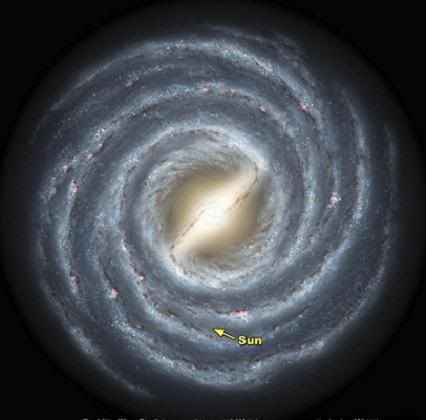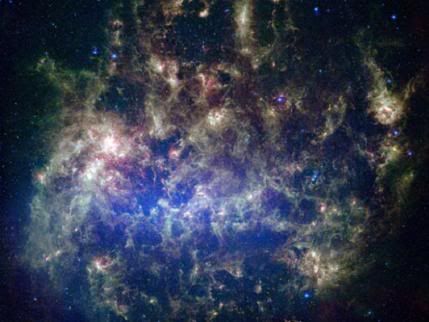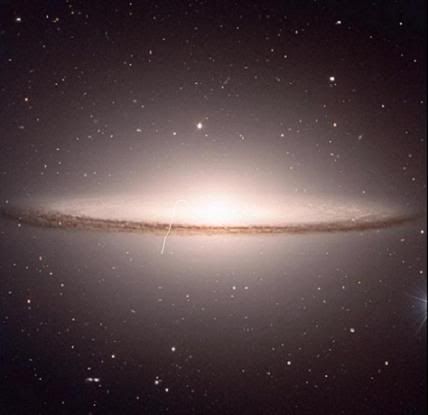Post by glactus on Sept 1, 2009 10:51:47 GMT
How galaxies evolve, an open question has been whether collisions with our dwarf galactic neighbors will one day tear apart the disk of the Milky Way. That grisly fate is unlikely, a new study now suggests.

The Milky Way galaxy
While astronomers know that such collisions have probably occurred in the past, the new computer simulations show that instead of destroying a galaxy, these collisions "puff up" a galactic disk, particularly around the edges, and produce structures called stellar rings.
The finding solves two mysteries: the likely fate of the Milky Way at the hands of its satellite galaxies - the most massive of which are the Large and Small Magellanic Clouds - and the origin of its puffy edges, which astronomers have seen elsewhere in the universe and dubbed "flares."

The Magellanic cloud
The mysterious dark matter that makes up most of the universe plays a role, the study found. Astronomers believe that all galaxies are embedded within massive and extended halos of dark matter, and that most large galaxies lie at the intersections of filaments of dark matter, which form a kind of gigantic web in our univers

The Sombrero galaxy & halo
Ohio State University astronomer Stelios Kazantzidis and his colleagues performed detailed computer simulations of galaxy formation to determine what would happen if a satellite galaxy - such as the Large Magellanic Cloud and its associated dark matter - collided with a spiral galaxy such as our own.
Their conclusion: The satellite galaxy would gradually disintegrate, while its gravity tugged at the larger galaxy's edge, drawing out stars and other material. The result would be a flared galactic disk such as that of the Milky Way, which starts out narrow at the center and then widens toward the edges.
The results may ease the mind of anyone who feared that our galactic neighbors and their associated dark matter would eventually destroy our galactic disk - albeit billions of years from now.

Credits: These are NASA/ Hubble images.
Text: This is part text only. See full text & all scientists involved at Space daily ,com
www.spacedaily.com/reports/Milky_Way_Probably_Not_Doomed_By_Galactic_Bombardment_999.html

The Milky Way galaxy
While astronomers know that such collisions have probably occurred in the past, the new computer simulations show that instead of destroying a galaxy, these collisions "puff up" a galactic disk, particularly around the edges, and produce structures called stellar rings.
The finding solves two mysteries: the likely fate of the Milky Way at the hands of its satellite galaxies - the most massive of which are the Large and Small Magellanic Clouds - and the origin of its puffy edges, which astronomers have seen elsewhere in the universe and dubbed "flares."

The Magellanic cloud
The mysterious dark matter that makes up most of the universe plays a role, the study found. Astronomers believe that all galaxies are embedded within massive and extended halos of dark matter, and that most large galaxies lie at the intersections of filaments of dark matter, which form a kind of gigantic web in our univers

The Sombrero galaxy & halo
Ohio State University astronomer Stelios Kazantzidis and his colleagues performed detailed computer simulations of galaxy formation to determine what would happen if a satellite galaxy - such as the Large Magellanic Cloud and its associated dark matter - collided with a spiral galaxy such as our own.
Their conclusion: The satellite galaxy would gradually disintegrate, while its gravity tugged at the larger galaxy's edge, drawing out stars and other material. The result would be a flared galactic disk such as that of the Milky Way, which starts out narrow at the center and then widens toward the edges.
The results may ease the mind of anyone who feared that our galactic neighbors and their associated dark matter would eventually destroy our galactic disk - albeit billions of years from now.
Credits: These are NASA/ Hubble images.
Text: This is part text only. See full text & all scientists involved at Space daily ,com
www.spacedaily.com/reports/Milky_Way_Probably_Not_Doomed_By_Galactic_Bombardment_999.html


